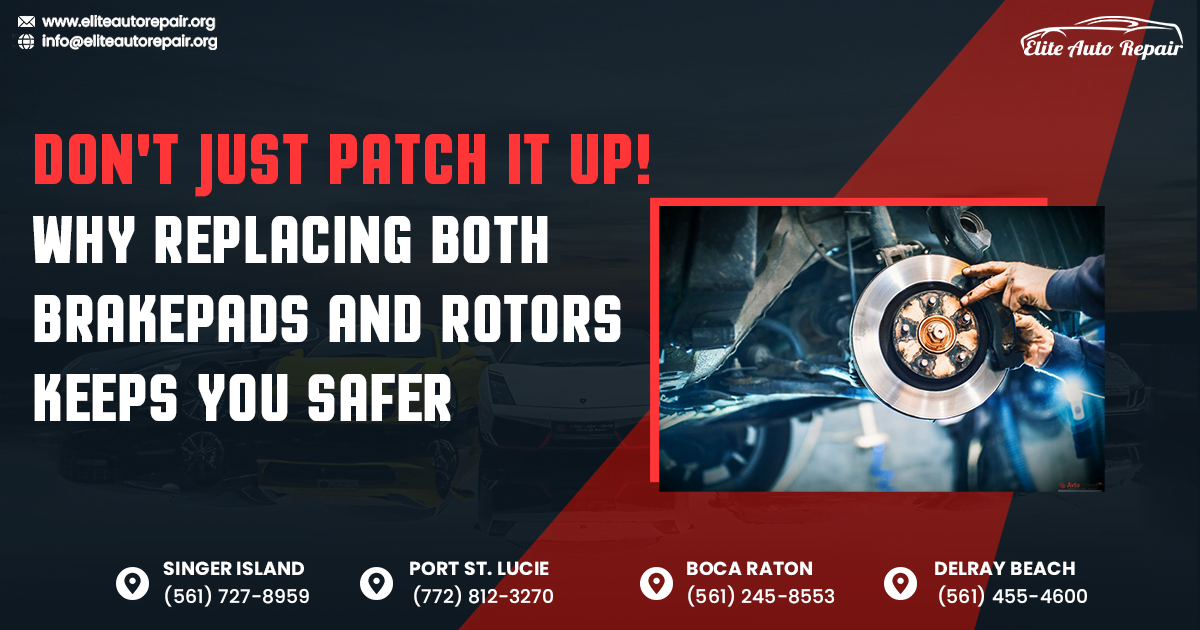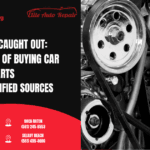Imagine cruising down the open road, music playing, the wind in your hair. Suddenly, you need to stop—whether it’s for a red light, a pedestrian, or a surprise obstacle. What makes that smooth stop possible? Your trusty brake pads! Here’s why keeping them fresh is absolutely vital for your ride.
Recognizing the signs early can help you address issues before they escalate into more significant problems, ensuring your safety on the road. If you experience any of these symptoms, it’s advisable to consult a mechanic for a thorough inspection and necessary repairs.
Common signs that indicate your car brake pads need replacement
Here’s a deeper explanation of the signs that your car may need brake repair
1. Squeaking or Squealing Sounds / Grinding Noise
When you apply the brakes and hear a high-pitched squeal, it often means that your brake pads are worn down. Most brake pads come with built-in wear indicators that make this sound to alert you that it’s time for replacement. Ignoring this could lead to more significant damage. If you hear a grinding noise when braking, it’s a serious issue. This sound usually means the brake pads have worn out completely, allowing the metal backing to scrape against the brake rotor. This can cause severe damage to the rotor, leading to costly repairs.
2. Vibration or Pulsation
Feeling a vibration or pulsation in the brake pedal when you brake could indicate warped rotors. Warped rotors can occur due to heat buildup or wear over time. This uneven surface can make braking less effective and lead to further damage if not addressed.
3. Soft or Spongy Brake Pedal
If your brake pedal feels soft or spongy, it could mean there’s air in the brake lines or a brake fluid leak. This can compromise braking power, making it difficult to stop your vehicle effectively. A soft pedal often indicates a serious issue that needs immediate attention.
4. Pulling to One Side
If your car pulls to one side when you brake, it suggests uneven brake wear or an issue with the brake system, such as a stuck caliper. This can affect your control over the vehicle and increase the risk of an accident.
5. Dashboard Warning Light
Many vehicles have a dashboard light that indicates a problem with the brake system. If this light comes on, it’s a sign that you should have your brakes inspected by a professional. Ignoring it could lead to a complete brake failure.
6. Brake Fluid Leaks
If you notice fluid pooling under your vehicle, especially near the wheels, it could be brake fluid leaking. Brake fluid is essential for the hydraulic brake system to function correctly, and a leak can lead to brake failure. This is a critical issue that needs immediate repair.
7. Bad Smell
A burning smell while driving or braking can indicate overheated brake pads or a problem in the braking system. Overheated brakes can lose effectiveness, which is dangerous. If you smell something burning, it’s crucial to stop driving and have your brakes checked.
8. Longer Stopping Distances
If you find yourself pressing the brake pedal harder or longer to stop, this is a clear indicator that your brakes may not be functioning properly. This can result from worn brake pads or other issues within the braking system.
Following, we have differentiate between the signs among brake pads and Rotors.
1. Thickness of Brake Pads
Most brake pads have a wear indicator that shows when they’re getting too thin. If the pads are less than 1/8 inch thick, it is time to replace them. Regularly check the thickness to avoid damaging the rotors.
2. Brake Pad Warning Light
Many vehicles have a dashboard warning light that indicates brake pad wear. If this light comes on, it’s a clear signal that you should check your brake pads and replace them if necessary.
3. Mileage and Age of Brake Pads
Check your vehicle’s owner manual for the recommended replacement interval, usually between 30,000 to 70,000 miles, depending on driving habits and conditions. If you’ve reached this mileage, it’s wise to inspect the pads. Even if the pads look okay, if they’re several years old (typically over 5-7 years), it’s worth having them inspected or replaced, as they can degrade over time regardless of mileage.
Common signs that indicate your car Rotors need to be replaced
Imagine gliding smoothly down the road, your vehicle responding perfectly to every touch of the brake pedal. But what happens when that perfect braking performance starts to falter? Enter the unsung hero of your braking system: the brake rotor. Here’s why these vital components may need to be replaced to keep your ride safe and smooth.
1. Warping: The Heat of Battle
Think of your rotors as the frontline soldiers in the heat of battle. When you brake hard or frequently, they can warp, causing your pedal to vibrate like a drum solo gone wrong. If you feel this shaking, it’s a sure sign your rotors are crying out for replacement!
3. Cracks and Rust
Rotors can develop cracks from the intense heat of braking, much like battle scars from a tough fight. If you spot these cracks, don’t hesitate—your safety is at stake! Replace them to ensure your braking power isn’t compromised. Imagine your rotors being ambushed by rust and corrosion. Exposure to moisture can create a stealthy enemy that affects performance. If you see signs of rust, it’s time to take action before it wreaks havoc on your braking system.
7. Performance Changes: The Warning Bell
If your car feels like it’s dragging its feet when you brake, or if you hear strange noises, it’s time to investigate. These performance changes can signal that your rotors are struggling and in need of replacement.
Impact of Replacing brake pads and rotors:
Advantages:
Let’s discover why replacing both brake pads and rotors is essential for optimal braking performance and safety.
1. Maximized Performance Brake pads and rotors work in tandem to provide effective stopping power. When both are in good condition, they complement each other, ensuring smooth and efficient braking. If you replace just one, the other might not perform as well, leading to a compromised braking system.
2. Preventing Uneven Wear Worn brake pads can damage rotors over time. If you only replace the pads, the damaged rotors can lead to uneven braking and decreased performance. Replacing both at the same time helps ensure even wear and extends the lifespan of your braking system.
3. Cost-Effectiveness While it might seem like a bigger expense to replace both at once, it can actually save you money in the long run. If you replace only the pads, you may end up needing to replace the rotors sooner due to wear and tear, which means additional labor costs and downtime.
4. Safety First Safety is paramount. Worn or damaged rotors can lead to brake failure, especially if they’re not matched with fresh pads. Replacing both ensures your braking system is fully functional and can respond effectively in emergency situations.
5. Improved Brake Feel New pads and rotors work together to provide a better brake feel. You’ll notice improved responsiveness, less noise, and smoother stopping. This can enhance your overall driving experience and instill more confidence behind the wheel.
6. Avoiding Vibration Issues Worn rotors can cause vibrations during braking, which can be uncomfortable and potentially dangerous. If you replace just the pads, the uneven surfaces of old rotors can still create these issues. Replacing both eliminates vibrations and ensures a smoother ride.
7. Maintaining Brake Balance Balanced braking is essential for handling and stability. New pads and rotors ensure that braking force is evenly distributed across all wheels, which is crucial for maintaining control, especially in emergency stops.
8. Better Heat Dissipation Braking generates heat, and both pads and rotors are designed to handle this stress. Replacing them together ensures they can dissipate heat effectively, reducing the risk of brake fade and maintaining performance under heavy use.
9. Easier Installation Replacing both at the same time often simplifies the installation process. Mechanics can address both components without needing to revisit the job later, saving time and reducing labor costs.
10. Peace of Mind Knowing that your brake pads and rotors are new gives you peace of mind. You can drive confidently, knowing that your braking system is in optimal condition and ready to handle whatever the road throws your way.
Wind-Up/ Conclusion
By keeping an eye on these signs and adhering to maintenance schedules, you can ensure your braking system remains effective and your driving experience is safe. If you’re unsure, it’s always best to consult a professional mechanic for advice! Replacing both brake pads and rotors together ensures your vehicle’s braking system is safe, efficient, and reliable. It’s an investment in your safety and the longevity of your vehicle!






“I took my BMW to Elite Auto Repair last month after noticing some vibrations when braking. The team there advised me to replace both the pads and rotors instead of just patching things up. I’m so glad I listened! The braking is much smoother now, and I feel way safer, especially on the highway. Highly recommend them for their honesty and expertise.”
“I’ve learned my lesson the hard way—patching up my brake pads without replacing the rotors led to uneven wear and even more issues down the road. Elite Auto Repair walked me through why changing both is important, and ever since they did the full replacement, I’ve felt a noticeable difference. No more squeaking or grinding, just smooth stops!”
“Shoutout to Elite Auto Repair for explaining why replacing both brake pads and rotors is essential. I used to think just replacing the pads would be enough, but after they showed me the wear on my rotors, I realized how critical it was. It’s been a game-changer for my driving confidence, especially during Florida’s rainy season.”
“I recently went to Elite Auto Repair for a routine brake check and was advised to replace both my pads and rotors. I was hesitant at first because of the cost, but now I’m so thankful I did. The braking feels precise, and I no longer have that annoying shudder when coming to a stop. The peace of mind is priceless.”
“Elite Auto Repair has been my go-to for years, and they always stress the importance of doing the job right the first time. When I replaced only the pads at a different shop, my car started making grinding noises within months. Elite Auto Repair fixed it up properly by replacing both the pads and rotors, and I haven’t had an issue since. These folks know their stuff!”
“I’m so glad Elite Auto Repair took the time to explain the risks of replacing just one part of the braking system. Their mechanics showed me the wear pattern on my rotors and how it would impact new pads if left unchanged. Now, my Porsche drives smoother than ever, and stopping is more responsive. It’s worth the investment for safety.”
“I can’t emphasize enough how much of a difference replacing both the brake pads and rotors has made. Elite Auto Repair took care of my Audi, and the braking feels brand new. They even provided tips on how to maintain the new setup for longer life. These guys truly care about their customers and their safety.”
“Elite Auto Repair changed my perspective on brake maintenance. Before, I’d only replace the pads, thinking it was enough. But after experiencing uneven braking and taking it to them, they showed me why replacing both parts was crucial. Now I know better, and I drive with much more confidence!”